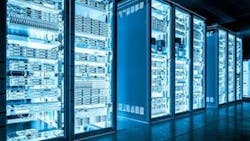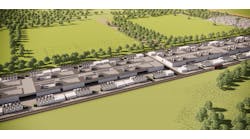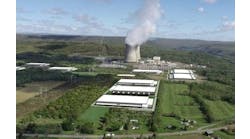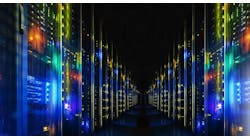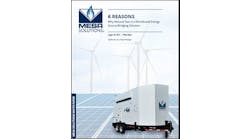Increasingly, microgrids are being deployed to provide carbon-free energy and resilience for data centers – notorious power hogs.
For example, Microsoft last year announced a partnership with microgrid provider Enchanted Rock and energy project developer U.S. Energy to power Microsoft's new data center in San Jose, California, during grid outages.
Providing solar energy to data centers
Powering data centers with clean energy is the focus of Donato Solar, a startup that aims to build solar energy installations to power new data centers in Illinois. The company gained $14.5 million in funding to move the projects closer to completion.
These efforts are underway for good reason. Domestically, data center power consumption is expected to triple between now and 2030, from 20 to 60 GW, said Sayles Braga, senior partner at Sidewalk Infrastructure Partners (SIP), an infrastructure developer that has a novel idea for addressing the challenge. SIP is a spinoff of Google owner Alphabet.
“Historically data centers used to be dozens or hundreds of megawatts,” said Braga. “Now we see them as potentially thousands of megawatts.” If data center developers continue to build them as they have in the past, the facilities will threaten the stability of the grid. “There’s no way to power a future digital infrastructure in this county without a different approach,” he said.
Verrus will build new data centers that separate critical and noncritical loads
SIP has created Verrus, a company that will construct new data centers designed to segregate critical and noncritical loads, then power them with microgrids that can employ the flexibility of batteries – along with flexible data center loads – to lower energy costs and carbon footprints, Braga said.
“Our primary goal is to build data centers that don’t break the grid and give customers what they need,” he said.
Verrus builds infrastructure to meet the differing energy requirements and workload needs of data centers.
Building data centers that separate server halls based on energy needs
For example, data centers can be built to separate server halls that house computing workloads such as web searches and flexible operations, including training artificial intelligence (AI) models. Verrus can share power assets between these different halls to improve the utilization of generation assets. In this way assets aren’t sitting idle to meet the peak needs of certain server halls.
The company uses software to optimize costs, emissions and grid support as well as smooth electrical peaks and valleys. It also provides low-carbon supplies whenever possible.
“This type of microgrid optimization in the context of data centers that can support critical load and interruptible loads is something that doesn't exist out there,” said Braga. “It’s an enormous opportunity.”
Microgrid batteries provide flexibility in energy use
Flexibility will come from the batteries Verrus will deploy. In addition, it will come from the varying needs of loads, which have some flexibility in terms of when they can run. Different data center functions – AI training, Google, gmail, YouTube or internal workloads – have different energy needs and different levels of uptime.
In addition, microgrid-powered data centers – rather than always taking power from the grid – can serve as utility partners, helping reduce peak loads, said Braga.
“We look at how we can flatten those demand spikes and spread out consumption so the utility can sell more power without increasing the risk to the grid. We’re not accelerating the spikiest part of their demand curve,” he said.
This involves designing to integrate the servers and the mechanical loads, including the equipment that cools computers, a large user of data center energy. AI computing, for example, uses different types of chips and requires different densities of power consumption.
Turning data halls on and off based on grid needs
“You have the ability to dynamically route power and turn data halls on and off based on when something is needed and when the grid needs power. It’s parsing the power and building infrastructure that is relevant to underlying workloads, rather than overbuilding infrastructure,” Braga said.
Applying Digital Twin Tech at the Microgrid Level
Verrus aims to avoid using diesel generation – a common backup for data centers – because it’s not allowed in some demand response programs. Also diesel generators are emissions heavy and tend to fail, he said. Batteries, solar and other distributed energy resources (DERs) allow for more flexibility and can be deployed depending on how the computing infrastructure needs them.
“The stitching that keeps it all together is software orchestration that allows data centers to be grid aware, carbon aware and compute aware,” he said. “If the customer is focused more on carbon-free energy, we optimize for that. If the focus is cost reduction, we can turn the dials on low cost.”
Software that optimizes for carbon emissions reduction
To achieve carbon reduction, for example, the software would choose solar that’s included in the microgrid, opt for grid power when renewable energy penetration on the grid is high, or send renewable-heavy grid power to the batteries to be released when there’s less renewable energy on the grid.
Verrus hopes to include solar with every installation, but it likely will represent a small percentage of the total energy needs, with California and Southwest installations most able to take advantage of solar. The company will also participate in demand response and other grid services programs to help out the grid and earn income.
Modular data centers can reduce energy consumption
Other companies are focusing on reducing data center consumption with different strategies. For example, Total Site Solutions provides modular data centers, said Darryll Dewan, the company’s CEO and president. Modular data centers are designed to be energy efficient and employ advanced cooling techniques such as liquid cooling.
Microgrids can be an important part of this strategy, Dewan pointed out.
“Microgrids can optimize energy use, reduce reliance on the grid during peak demand, deliver alternative, renewable energy sources to the data center and provide the data center more localized control over their energy sources,” he said.
And microgrids can avoid the long lead times for getting distribution lines to data center facilities.
Another strategy is to power data centers directly from nuclear power plants.
Powering a data center from a nuclear plant
Amazon Web Services (AWS) is acquiring a 960-MW data center campus being developed in Pennsylvania that will be directly powered with nearby nuclear energy.
Talen Energy, which owns both the Cumulus data center project as well as the Susquehanna nuclear power plant, agreed to sell the facility to AWS for approximately $650 million. The agreement includes a provision in which Talen will receive additional revenue from AWS for the dispatch of carbon-free power back into the grid.
AWS will install its hyperscale data center at the site. Talen will supply direct-connect nuclear power from its Susquehanna power plant to the AWS campus under a long-term power purchase agreement.
As data centers proliferate, worldwide data center energy consumption will continue to grow at a worldwide annual rate of 16%, according to IDC, which provides market research. In fact, data center energy usage is expected to increase from 1.2% of global electricity demand to 2.5% of that demand, said IDC.
The important role of microgrids and DERs
The growth is expected to spark the increased use of microgrids to reduce the negative effects of data center energy consumption, said Dewan.
“As demand and scarcity grow, so will innovation in the DER and microgrid community. Data centers and the future of our technological infrastructure will rely on that innovation and creative, collaborative solutions between communities, policymakers and industry,” Dewan said.
Enchanted Rock, DC Byte Headlining Microgrid 2024 Session
From Queues to Quick Deployment: One of 20 Microgrid Sessions Covering All Facets
Happening April 22-24 in Baltimore at the Marriott Waterfront
